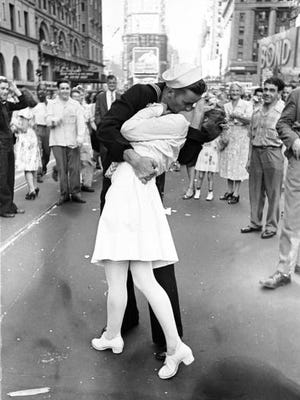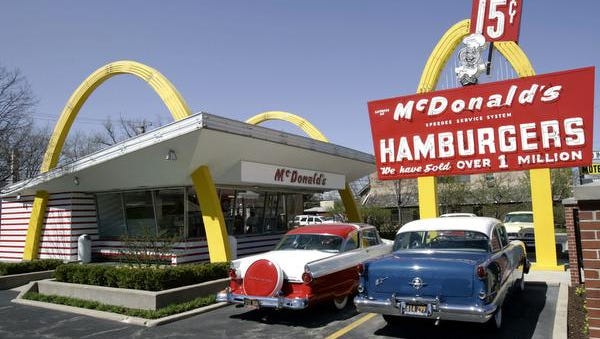How Did American Society Change During Ww2

Even as World War II was ending 70 years ago, Americans already knew it had transformed their land. What they didn't know was just how much or for how long.
In that last wartime summertime of 1945, the seeds of a new America had been sown. Not just postwar America — the Babe Boom, the Common cold War, the Affluent Society, the sprawling suburbs — only the one in which we alive today.
Look closely at the state of war years, and you can see those seeds.
•Two brothers who had opened a bulldoze-in restaurant in San Bernardino, Calif., were struck by working families' desire for cheap meals served fast — faster than their carhops could serve them. Their name was McDonald.
•While building homes for federal war workers, a family-owned Long Isle construction company had learned how to lay dozens of concrete foundations in a single day, and preassemble uniform walls and roofs. The business firm's name was Levitt & Sons.
•A young, black Army lieutenant was court-martialed in 1944 later on he refused to sit in the back of a military bus at Camp Hood, Texas. The trial prevented him from serving overseas, but he was acquitted. His proper noun was Jackie Robinson.
•In 1944, an Army Air Forces photographer discovered a beautiful young woman working on an aircraft assembly line in Burbank, Calif. One of his photos helped land her a modeling job. Her name was Norma Jean Bakery. Later she would change it to Marilyn Monroe.

•In 1945, engineers were finishing a sort of "electronic brain" for the Army. Equipped with xviii,000 vacuum tubes instead of the usual electrical switches, information technology could do about five,000 computations per 2d — 4,996 more than the best electric calculator. They called it an Electronic Numerical Integrator and Estimator. Simply the last word stuck.
In the side by side decade, the Levitts would build Levittown, N.Y., the most famous postwar suburb. McDonald's, focusing on assembly line hamburgers, would begin its rising to global fast-food dominance. Robinson would integrate Major League Baseball game.
And Monroe would get the first "Playmate of the Month" in a new magazine called Playboy, whose editor got his start in media during the war at a war machine paper. His name was Hugh Hefner.
World War Ii too marked the beginning of trends that took decades to fully develop, including technological disruption, global economic integration and digital communication.
More broadly, the wartime home front put a premium on something that's even more crucial today: innovation.

It helped explicate America'south product miracle. A nation that in 1938 was making virtually no weapons was, by 1943, making more twice as many every bit of all its enemies combined.
"Never before had war demanded such technological experimentation and business concern arrangement," historian Allen Nevins later wrote. "The genius of the land of Whitney, Morse, and Edison precisely fitted such a war."
America not merely made more weapons than its enemies, it kept making new and amend ones. By the stop of the state of war, information technology was said that no major battle was won with the aforementioned weapons as the battle that preceded it; innovation had go a constant.
The Office of Scientific Research and Development, directed past mathematician Vannevar Bush, organized the scientists and engineers who developed many valuable weapons.
Radar, improved depth charges and long-range bombers turned the tide against German submarines; the long range Mustang fighter protected Allied bombers over Europe afterward 1943; the B-29 Superfortress allowed the Air Forcefulness to pulverize Nihon with virtual dispensation past 1945.
The nation's science labs were mobilized. Almanac federal spending on research and evolution increased more than 20-fold during the war.
Medical researchers produced a course of pharmaceuticals whose nickname — "wonder drugs" — pretty much summed them up. Streptomycin, the first drug constructive confronting the cause of tuberculosis, was the best known in a series of new antibiotics.
Penicillin, which had been discovered in 1928, was mass produced during the war to treat blood poisoning and boxing wounds. A new procedure to produce stale blood plasma immune battleground transfusions.
Other developments included quinine substitutes to fight malaria, and numerous repellants and insecticides (including, unfortunately, Ddt) used confronting pests causing epidemics of typhus and malaria.
Government scientists refined products (tv set, air conditioning) and developed new ones. The figurer introduced at MIT in 1942 weighed 100 tons and had two,000 electronic tubes, 150 electric motors and 200 miles of wire.
In Palo Alto, Calif., a visitor started in a garage by electrical engineers William Hewlett and David Packard was making radio, sonar, and radar devices, besides equally artillery crush fuses. Packard ran the company while Hewlett served in the Army Signal Corps, unaware that they were founders of what would get Silicon Valley.
Wartime shortages gave rise to products whose greatest days were ahead, including plastics (used to replace scarce metals), frozen foods (which saved trips to the store) and microfilm (for shipping civilian-military "V-mail service" overseas).
The war also raised issues that would become fifty-fifty more pressing in years to come up.
The war was witness to the greatest single violation of civil rights in U.S. history — the internment of well-nigh 120,000 Japanese-Americans (two-thirds of them U.S. citizens) living in Pacific Coast states. Supposedly designed to fight espionage and sabotage, the move in fact was motivated by war hysteria, racism and political expediency.
For years, this outrage was all but forgotten. In 1988, however, President Ronald Reagan signed a law that provided financial redress of $twenty,000 for each surviving detainee. Merely the Supreme Court's expansive interpretation of government powers in wartime in the Korematsu case, which upheld the internment, has never been overturned.
The internment was the effect of an executive society, a presidential prerogative that has become increasingly controversial. But during the state of war the executive branch also banned pleasance drives and sliced staff of life, and seized control of the strike-leap retail behemothic Montgomery Ward under the legal justification that it was "useful" to the state of war endeavor. When Ward's president refused to leave his function, authorities agents carried him out in his chair.
Decades before Edward Snowden'due south revelations about authorities spying, military censors on the home front had authorization to open up and read every slice of mail that entered or left the country; to scan every cable; and to screen every phone call. A letter from a soldier overseas often arrived with a few words, a sentence or an unabridged paragraph snipped out, and the envelope resealed with a chip of tape bearing the label "Opened by Censor."
Issues developed during the war that would bedevil the nation for years. Los Angeles had its offset smog attack in 1943. In New York City, at that place were more than and more than reports of an old crime with a new proper noun: mugging.
And anyone who thinks scarlet-baiting was a postwar innovation should heed to Thomas Dewey, the 1944 GOP presidential candidate, who chosen President Franklin D. Roosevelt "indispensable to Earl Browder" the head of the American Communist Party.
A communist, Dewey told an audition, is "anyone who supports (Roosevelt's) fourth term and then our form of regime may more easily be changed."
Income inequality? Although Rosie the Riveter was the patriotic, symbolic personification of the 5 million U.S. women who went to piece of work during the war, their pay on average was 60% of men's — despite authorities rules banning such discrimination in war plants.
By war's cease, Americans were used to looking to Washington for solutions. But the state of war also reinforced an attitude that remains resonant today: skepticism almost government.
For example, after Pearl Harbor the government tried to discourage the practice of planting home "victory gardens," which were popular in World State of war I. The nation already had an agricultural surplus, and more product would hurt farm prices.
Undeterred, within a few months Americans had planted victory gardens on Ellis Island and Alcatraz and everywhere in betwixt — about 10 million in all. Within two years, twenty 1000000 victory gardens were producing eight 1000000 tons of food.
By then, the victory gardeners' instincts had been vindicated; snarled transportation and subcontract labor shortages produced spot fruit and vegetable shortages. The amateurs, the secretarial assistant of Agriculture admitted, "surprised a lot of people."
All the war's changes, apparent and embryonic, contributed to a rich irony: Although Americans abroad in the military lived on memories of the state they'd left behind, by war's end that America was already disappearing.
The demands of winning a war would transform the home front into something virtually equally exotic as the places where the soldiers fought — a land more than affluent and more only, more open and more mobile, more polluted and more than violent than the i of which they'd dreamed.
Source: https://www.usatoday.com/story/news/nation/2015/07/18/70-years-later-how-world-war-ii-changed-america/30334203/
Posted by: smithdecorichiggy.blogspot.com


0 Response to "How Did American Society Change During Ww2"
Post a Comment